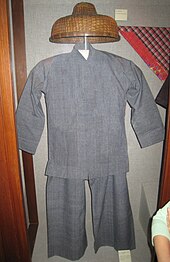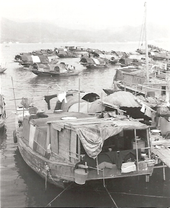
Guangzhou, previously romanized as Canton or Kwangchow, is the capital and largest city of Guangdong province in southern China. Located on the Pearl River about 120 km (75 mi) northwest of Hong Kong and 145 km (90 mi) north of Macau, Guangzhou has a history of over 2,200 years and was a major terminus of the Silk Road.
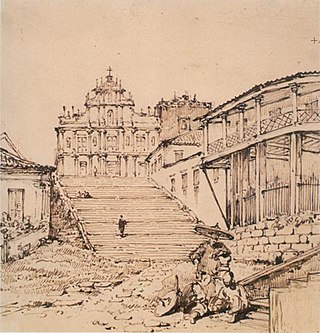
Macau is a special administrative region (SAR) of the People's Republic of China. It was leased to Portugal in 1557 as a trading post in exchange for a symbolic annual rent of 500 tael. Despite remaining under Chinese sovereignty and authority, the Portuguese came to consider and administer Macau as a de facto colony. Following the signing of the Treaty of Nanking between China and Britain in 1842, and the signing of treaties between China and foreign powers during the 1860s, establishing the benefit of "the most favoured nation" for them, the Portuguese attempted to conclude a similar treaty in 1862, but the Chinese refused, owing to a misunderstanding over the sovereignty of Macau. In 1887 the Portuguese finally managed to secure an agreement from China that Macau was Portuguese territory. In 1999 it was handed over to China. Macau was the last extant European territory in continental Asia.
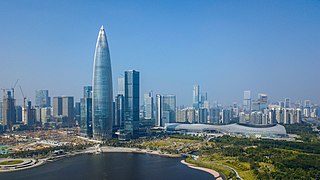
Guangdong, previously romanized as Kwangtung or Canton, is a coastal province in South China, on the north shore of the South China Sea. The provincial capital is Guangzhou. With a population of 126.84 million across a total area of about 179,800 km2 (69,400 sq mi), Guangdong is China's most populous province and its 15th-largest by area, as well as the third-most populous country subdivision in the world after the Indian states of Uttar Pradesh and Bihar.
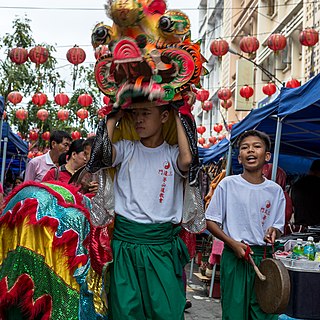
The Hakka, sometimes also referred to as Hakka-speaking Chinese, or Hakka Chinese, or Hakkas, are a southern Han Chinese subgroup whose principal settlements and ancestral homes are dispersed widely across the provinces of southern China and who speak a language that is closely related to Gan, a Han Chinese dialect spoken in Jiangxi province. They are differentiated from other southern Han Chinese by their dispersed nature and tendency to occupy marginal lands and remote hilly areas. The Chinese characters for Hakka literally mean "guest families".

Yue is a branch of the Sinitic languages primarily spoken in Southern China, particularly in the provinces of Guangdong and Guangxi.
The Macanese people are a multiracial East Asian ethnic group that originated in Macau in the 16th century, consisting of people of predominantly mixed Cantonese and Portuguese as well as Malay, Japanese, English, Dutch, Sinhalese, and Indian ancestry.

The Baiyue, Hundred Yue, or simply Yue, were various ethnic groups who inhabited the regions of southern China and northern Vietnam during the 1st millennium BC and 1st millennium AD. They were known for their short hair, body tattoos, fine swords, and naval prowess.
Cantonese is the traditional prestige variety of Yue Chinese, a Sinitic language belonging to the Sino-Tibetan language family. It originated in the city of Guangzhou and its surrounding Pearl River Delta.

Huizhou is a city in central-east Guangdong Province, China, forty-three miles north of Hong Kong. Huizhou borders the provincial capital of Guangzhou to the west, Shenzhen and Dongguan to the southwest, Shaoguan to the north, Heyuan to the northeast, Shanwei to the east, and Daya Bay of the South China Sea to the south. As of the 2020 census, the city has about 6,042,852 inhabitants and is administered as a prefecture-level city. Huizhou's core metropolitan area, which is within Huicheng and Huiyang Districts, is home to around 2,090,578 inhabitants.

The Hoklo people are a Han Chinese subgroup who speak Hokkien, a Southern Min language, or trace their ancestry to southeastern Fujian in China, and known by various related terms such as Banlam people, Minnan people, Fujianese people or more commonly in Southeast Asia as the Hokkien people. The Hokkien people are found in significant numbers in mainland China, Taiwan, Hong Kong, Macau, Singapore, Malaysia, Philippines, Indonesia, Brunei, Myanmar, and the United States. The Hokkien people have a distinct culture and architecture, including Hokkien shrines and temples with tilted sharp eaves, high and slanted top roofs, and finely detailed decorative inlays of wood and porcelain. The Hokkien language, which includes Taiwanese Hokkien, is the mainstream Southern Min, which is partially mutually intelligible to the Teochew language, Hainanese, Leizhou Min, and Haklau Min.
The Han Chinese people can be defined into subgroups based on linguistic, cultural, ethnic, genetic, and regional features. The terminology used in Mandarin to describe the groups is: "minxi", used in Mainland China or "zuqun", used in Taiwan. No Han subgroup is recognized as one of People's Republic of China's 56 official ethnic groups. In Taiwan, only three subgroups, Hakka, Hoklo, and Waishengren are recognized.
Cantonese culture, or Lingnan culture, refers to the regional Chinese culture of the region of Lingnan: twin provinces of Guangdong and Guangxi, the names of which mean "eastern expanse" and "western expanse", respectively.
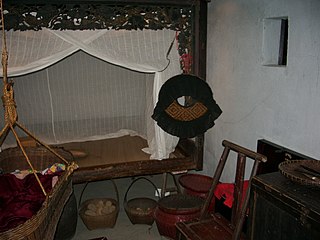
Punti is a Cantonese endonym referring to the native Cantonese people of Guangdong and Guangxi. Punti designates Weitou dialect-speaking locals in contrast to other Yue Chinese speakers and others such as Taishanese people, Hoklo people, Hakka people, and ethnic minorities such as the Zhuang people of Guangxi and the boat-dwelling Tanka people, who are both descendants of the Baiyue – although the Tanka have largely assimilated into Han Chinese culture.

The Cantonese people or Yue people, are a Han Chinese subgroup originating from Guangzhou and its satellite cities and towns. In a more general sense "Cantonese people" can refer to any Han Chinese people originating from or residing in the provinces of Guangdong and Guangxi, or it may refer to the inhabitants of Guangdong province alone.
The Punti–Hakka Clan Wars were a conflict between the Hakka and the Cantonese people in Guangdong, China between 1855 and 1867. The wars were most fierce around the Pearl River Delta, especially in Toi Shan of the Sze Yup counties. The wars resulted in roughly a million dead with many more displaced civilians.
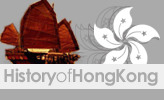
Indigenous inhabitants are people descended through the male line from a person who was in 1898, before Convention for the Extension of Hong Kong Territory was signed, a resident of an established village in the New Territories of Hong Kong.

After taking power in 1949, the Chinese Communist Party (CCP) embarked upon a series of campaigns with the aim of eradicating prostitution from mainland China by the early 1960s. Since the loosening of government controls over society in the early 1980s, prostitution in mainland China not only has become more visible, but can now be found throughout both urban and rural areas. In spite of government efforts, prostitution has now developed to the extent that it comprises an industry, one that involves a great number of people and produces a considerable economic output. Prostitution has also become associated with a number of issues, including organized crime, government corruption, hypocrisy, as well as sexually transmitted diseases. Notably, a CCP official who was a major provincial campaigner against corruption was removed from his post and expelled from the party after he was caught in a hotel room with a prostitute in 2007.
Cantonese people represent the largest group in Hong Kong. The definition usually includes people whose ancestral homes are in Yue Chinese speaking regions of Guangdong province, specifically the guangfu (廣府) region, although sometimes Sze Yap people, the Hakka people or Teochew people may be included. Historic Hong Kong censuses distinguished people of Guangdong origin into Guangzhou and Macau, Sze Yap (Siyi), Chaozhou, and Hainan origins, as well as the Indigenous people of the New Territories.
Hongkongers, Hong Kongers, Hong Kongese, Hongkongese, Hong Kong citizens and Hong Kong people are demonyms that refer to a resident of Hong Kong, although they may also refer to others who were born and/or raised in the territory.
Macau people are people who originate from or live in Macau.


